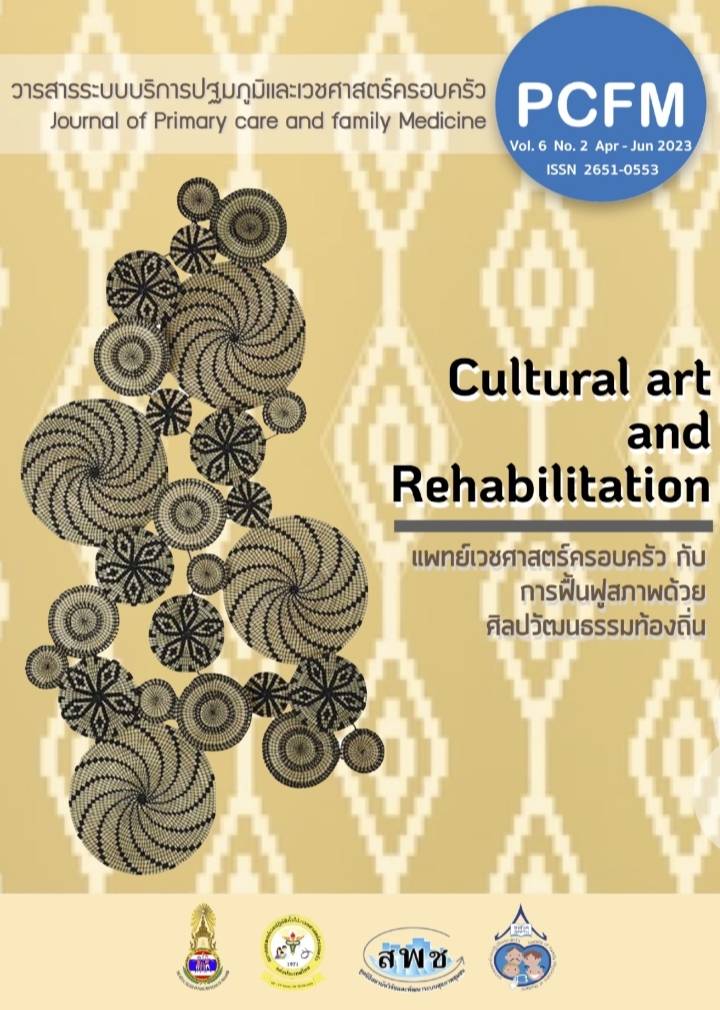Short Version of Caregiver Burden Screening Tool in Patients with Stroke: Development and Validation Study
Main Article Content
Abstract
ABSTRACT
Background: Stroke is the main cause of disability, and had the potential to impact caregiver burden and caregiver burnout. Assessing the caregiver burden and providing proper care to caregivers will reduce that condition. The most widely used tool for assessing caregiver burden was the 22-item Zarit burden interview, which had considerable time limitation for assessment. However, the short version of the Zarit burden interview tool was not found to assess the burden of care among caregivers of stroke patients.
Objective: To develop and evaluate caregiver burden screening tool in patients with stroke.
Study design: Diagnostic study
Method: Develop a screening tool based on reviewing factors related to caregiver burden of caregivers and analyze the construct validity of the screening tool by using exploratory factor analysis. Find the cut-off point and evaluate the quality of the screening tool.
Result: Totally, 85 caregivers of stroke patients were enrolled, 15.29% of those had caregiver burden. The screening tool consisted of 3 questions. The Cronbach's alpha coefficient was 0.800. The cut-off point was 7 points. The sensitivity and specificity of screening tools was 69.2% and 69.4%, respectively. The positive predictive value, negative predictive value, likelihood ratios for positive test and likelihood ratios for negative test was 29.0%, 92.6%, 2.27 and 0.78, respectively.
Conclusion: This screening tool can perform initial screening. However, improvements are still required for more quality tools.
Keywords: caregiver burden, screening, stroke
Article Details

This work is licensed under a Creative Commons Attribution-NonCommercial-NoDerivatives 4.0 International License.
The content and information in articles published in the PCFM journal are solely the opinions and responsibilities of the authors. The journal's editorial board does not necessarily agree with or share any responsibility for them.
All articles, information, content, images, etc., published in the PCFM journal are the copyright of the PCFM journal. If any individual or organization wishes to reproduce, distribute, or use any part or the entirety of the content, they must obtain written permission from the PCFM journal beforehand.
References
The top 10 causes of death [Internet]. [cited 2021 April 25]. Available from: https://www.who.int/news-room/fact-sheets/detail/the-top-10-causes-of-death
Johnson CO, Nguyen M, Roth GA, Nichols E, Alam T, Abate D, et al. Global, regional, and national burden of stroke, 1990–2016: a systematic analysis for the Global Burden of Disease Study 2016. Lancet Neurol. 2019 May;18(5):439–58.
นิรชา ภูวธนารักษ์ พบ, ภัควีร์ นาคะวิโร พบ. ความชุกและปัจจัยที่เกี่ยวข้องกับความรู้สึกเป็นภาระของผู้ดูแลผู้ป่วยโรคหลอดเลือดสมอง Prevalence and Associated Factors of Caregiver Burden among Stroke Patients. วารสารสมาคมเวชศาสตร์ป้องกันแห่งประเทศไทย. 2563;1(10):1–11.
อรพรรณ ฟูมณีโชติ. การดูแลผู้ให้การดูแล. [อินเทอร์เน็ต]. 2560[เข้าถึงเมื่อ 21 ตุลาคม 2563]. เข้าถึงได้จาก https://meded.psu.ac.th/binla/class04/388_441/Caring_of_the_Caregiver/index.html
Yu Y, Liu Z-W, Zhou W, Chen X-C, Zhang X-Y, Hu M, et al. Assessment of Burden Among Family Caregivers of Schizophrenia: Psychometric Testing for Short-Form Zarit Burden Interviews. Front Psychol. 2018;9:2539.
Whalen KJ, Buchholz SW. The reliability, validity and feasibility of tools used to screen for caregiver burden: a systematic review. JBI Libr Syst Rev. 2009;7(32):1373–430.
Pinyopornpanish K, Pinyopornpanish M, Wongpakaran N, Wongpakaran T, Soontornpun A, Kun P. Investigating psychometric properties of the Thai version of the Zarit Burden Interview using rasch model and confirmatory factor analysis. BMC Res Notes. 2020 Dec 1;13.
นฤมล สุดใจ. การคำนวณขนาดตัวอย่างสำหรับการศึกษาวิจัยเกี่ยวกับการตรวจวินิจฉัย. J Med Health Sci. 27(2):167–82.
Oliva-Moreno J, Peña-Longobardo LM, Mar J, Masjuan J, Soulard S, Gonzalez-Rojas N, et. al. Determinants of Informal Care, Burden, and Risk of Burnout in Caregivers of Stroke Survivors: The CONOCES Study. Stroke. 2018;49(1):140–6.
Oni O, Olagunju A, Okpataku C, Erinfolami A, Adeyemi J. Predictors of caregiver burden after stroke in Nigeria: Effect on psychosocial well-being. Indian J Psychiatry. 2019;61(5):457.
Zhu W, Jiang Y. Determinants of caregiver burden of patients with haemorrhagic stroke in China. Int J Nurs Pract. 2019 Apr;25(2):e12719.
Kruithof WJ, Post MWM, van Mierlo ML, van den Bos GAM, de Man-van Ginkel JM, Visser-Meily JMA. Caregiver burden and emotional problems in partners of stroke patients at two months and one year post-stroke: Determinants and prediction. Patient Educ Couns. 2016 Oct;99(10):1632–40.
ศรีนวล ชวศิริ, ธนากร ธนามี. ความชุกและปัจจัยที่เกี่ยวข้องกับความรู้สึกเป็นภาระของผู้ดูแลหลักของผู้ป่วยเด็กพิการ ในสาขาเวชศาสตร์ฟื้นฟูเด็ก คณะแพทยศาสตร์ศิริราชพยาบาล. J Thai Rehabil Med. 2018;28(2):54–61.
ธนาสิทธิ์ วิจิตราพันธ์. ความชุกและปัจจัยที่มีผลต่อภาระในการดูแลของผู้ดูแลผู้ป่วยโรคหลอดเลือดสมอง. วารสารการส่งเสริมสุขภาพและอนามัยสิ่งแวดล้อมล้านนา. 2559;6(1):56–62.
Wu C, Skidmore ER, Rodakowski J. Relationship Consensus and Caregiver Burden in Adults with Cognitive Impairments 6 Months Following Stroke. PM&R. 2019 Jun;11(6):597–603.
สาริกข์ พรหมมารัตน์. ปัจจัยที่ส่งผลต่อภาระดูแลของผู้ดูแลผู้สูงอายุ อำเภอบ้านโฮ่ง จังหวัดลำพูน. วารสารสาธารณสุขล้านนา. 2016;12(1):57–64.
อารยา องค์เอี่ยม, พงศ์ธารา วิจิตเวชไพศาล. การตรวจสอบคุณภาพเครื่องมือวิจัย.วิสัญญีสาร 2561;44(1):36-42.
ชนัญชิดาดุษฎี ทูลศิริ, รัชนี สรรเสริญ, วรรณรัตน์ ลาวัง. การพัฒนาแบบวัดภาระในการดูแลของผู้ดูแลผู้ป่วยเรื้อรัง. วารสารการพยาบาลและการศึกษา. 2011;4(1):62–75.
กรมการแพทย์ กระทรวงสาธารณสุข, ราชวิทยาลัยแพทย์เวชศาสตร์ฟื้นฟูแห่งประเทศไทย, สภากายภาพบำบัด, สมาคมนักกิจกรรมบำบัด/อาชีวบำบัดแห่งประเทศไทย, สำนักงานคณะกรรมการอุดมศึกษา กระทรวงศึกษาธิการ, สถาบันประสาทวิทยา กรมการแพทย์ กระทรวงสาธารณสุข. แนวทางการฟื้นฟูสมรรถภาพผู้ป่วยโรคหลอดเลือดสมอง (Clinical Practice Guidelines for Stroke Rehabilitation). ฉบับปรับปรุงครั้งที่ 1. 2550. 56–57 p.
Swets JA. Measuring the accuracy of diagnostic systems. Science. 1988 Jun 3;240(4857):1285–93.


